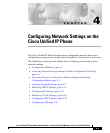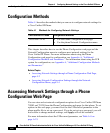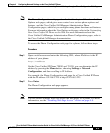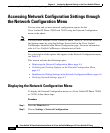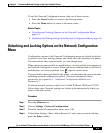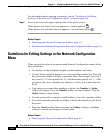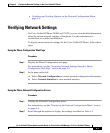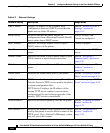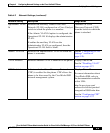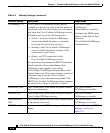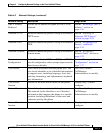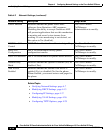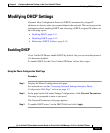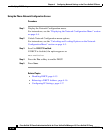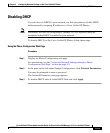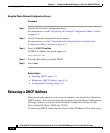
Chapter 4 Configuring Network Settings on the Cisco Unified IP Phone
Verifying Network Settings
4-8
Cisco Unified IP Phone Administration Guide for Cisco Unified CallManager 4.2, Cisco Unified IP Phone
OL-8617-01
Table 4-2 Network Settings
Network Setting Description Usage Notes
DHCP Server Displays IP address of the Dynamic Host
Configuration Protocol (DHCP) server that the
phone uses to obtain IP address.
See the “Modifying DHCP
Settings” section on
page 4-13.
BootP Server Indicates whether the phone obtains its
configuration from a Bootstrap Protocol (BootP)
server rather than a DHCP server.
Always displays No.
Cannot be configured.
MAC Address Identifies the unique Media Access Control
(MAC) address of the phone.
Cannot configure.
Host Name Identifies the unique host name assigned to the
phone.
Obtained from the DHCP
server.
Domain Name Identifies the name of the Domain Name System
(DNS) domain in which the phone resides.
See the “Assigning a
Domain Name” section on
page 4-22.
IP Address Indicates the Internet Protocol (IP) address of the
phone.
See the “Assigning an IP
Address” section on
page 4-18.
Subnet Mask Indicates the subnet mask used by the phone. See the “Assigning a Subnet
Mask” section on page 4-21.
TFTP Server 1-2 TFTP Server 1 indicates the primary Trivial File
Transfer Protocol (TFTP) server used by the phone
to obtain configuration files.
TFTP Server 2 displays the IP address of the
backup TFTP server, which is used to obtain
configuration files and software upgrades if the
primary TFTP server is unavailable.
See the “Assigning a TFTP
Sever” section on page 4-29.
Default Router 1 Identifies the default gateway used by the phone. See the “Assigning a Default
Router” section on
page 4-19.
DNS Servers 1-2 Indicates the Domain Name System (DNS) server
used by the phone to resolve the host name of the
TFTP server, Cisco Unified CallManager system
and web server host names.
See the “Assigning DNS
Servers” section on
page 4-24.



